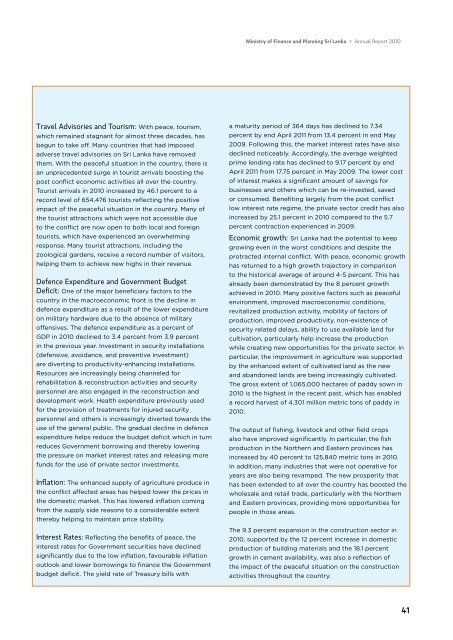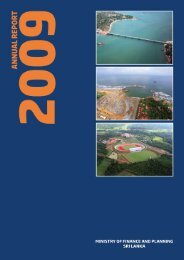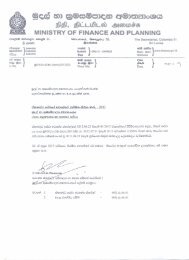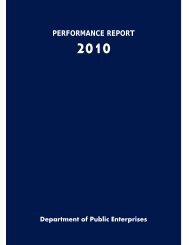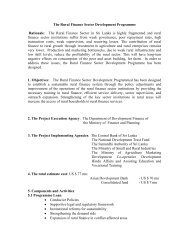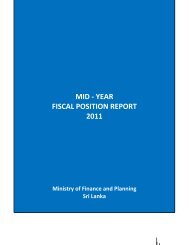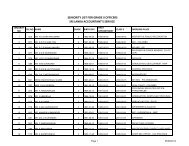Annual Report 2010 - Ministry of Finance and Planning
Annual Report 2010 - Ministry of Finance and Planning
Annual Report 2010 - Ministry of Finance and Planning
Create successful ePaper yourself
Turn your PDF publications into a flip-book with our unique Google optimized e-Paper software.
<strong>Ministry</strong> <strong>of</strong> <strong>Finance</strong> <strong>and</strong> <strong>Planning</strong> Sri Lanka > <strong>Annual</strong> <strong>Report</strong> <strong>2010</strong>Travel Advisories <strong>and</strong> Tourism: With peace, tourism,which remained stagnant for almost three decades, hasbegun to take <strong>of</strong>f. Many countries that had imposedadverse travel advisories on Sri Lanka have removedthem. With the peaceful situation in the country, there isan unprecedented surge in tourist arrivals boosting thepost conflict economic activities all over the country.Tourist arrivals in <strong>2010</strong> increased by 46.1 percent to arecord level <strong>of</strong> 654,476 tourists reflecting the positiveimpact <strong>of</strong> the peaceful situation in the country. Many <strong>of</strong>the tourist attractions which were not accessible dueto the conflict are now open to both local <strong>and</strong> foreigntourists, which have experienced an overwhelmingresponse. Many tourist attractions, including thezoological gardens, receive a record number <strong>of</strong> visitors,helping them to achieve new highs in their revenue.Defence Expenditure <strong>and</strong> Government BudgetDeficit: One <strong>of</strong> the major beneficiary factors to thecountry in the macroeconomic front is the decline indefence expenditure as a result <strong>of</strong> the lower expenditureon military hardware due to the absence <strong>of</strong> military<strong>of</strong>fensives. The defence expenditure as a percent <strong>of</strong>GDP in <strong>2010</strong> declined to 3.4 percent from 3.9 percentin the previous year. Investment in security installations(defensive, avoidance, <strong>and</strong> preventive investment)are diverting to productivity-enhancing installations.Resources are increasingly being channeled forrehabilitation & reconstruction activities <strong>and</strong> securitypersonnel are also engaged in the reconstruction <strong>and</strong>development work. Health expenditure previously usedfor the provision <strong>of</strong> treatments for injured securitypersonnel <strong>and</strong> others is increasingly diverted towards theuse <strong>of</strong> the general public. The gradual decline in defenceexpenditure helps reduce the budget deficit which in turnreduces Government borrowing <strong>and</strong> thereby loweringthe pressure on market interest rates <strong>and</strong> releasing morefunds for the use <strong>of</strong> private sector investments.Inflation: The enhanced supply <strong>of</strong> agriculture produce inthe conflict affected areas has helped lower the prices inthe domestic market. This has lowered inflation comingfrom the supply side reasons to a considerable extentthereby helping to maintain price stability.Interest Rates: Reflecting the benefits <strong>of</strong> peace, theinterest rates for Government securities have declinedsignificantly due to the low inflation, favourable inflationoutlook <strong>and</strong> lower borrowings to finance the Governmentbudget deficit. The yield rate <strong>of</strong> Treasury bills witha maturity period <strong>of</strong> 364 days has declined to 7.34percent by end April 2011 from 13.4 percent in end May2009. Following this, the market interest rates have alsodeclined noticeably. Accordingly, the average weightedprime lending rate has declined to 9.17 percent by endApril 2011 from 17.75 percent in May 2009. The lower cost<strong>of</strong> interest makes a significant amount <strong>of</strong> savings forbusinesses <strong>and</strong> others which can be re-invested, savedor consumed. Benefiting largely from the post conflictlow interest rate regime, the private sector credit has alsoincreased by 25.1 percent in <strong>2010</strong> compared to the 5.7percent contraction experienced in 2009.Economic growth: Sri Lanka had the potential to keepgrowing even in the worst conditions <strong>and</strong> despite theprotracted internal conflict. With peace, economic growthhas returned to a high growth trajectory in comparisonto the historical average <strong>of</strong> around 4-5 percent. This hasalready been demonstrated by the 8 percent growthachieved in <strong>2010</strong>. Many positive factors such as peacefulenvironment, improved macroeconomic conditions,revitalized production activity, mobility <strong>of</strong> factors <strong>of</strong>production, improved productivity, non-existence <strong>of</strong>security related delays, ability to use available l<strong>and</strong> forcultivation, particularly help increase the productionwhile creating new opportunities for the private sector. Inparticular, the improvement in agriculture was supportedby the enhanced extent <strong>of</strong> cultivated l<strong>and</strong> as the new<strong>and</strong> ab<strong>and</strong>oned l<strong>and</strong>s are being increasingly cultivated.The gross extent <strong>of</strong> 1,065,000 hectares <strong>of</strong> paddy sown in<strong>2010</strong> is the highest in the recent past, which has enableda record harvest <strong>of</strong> 4.301 million metric tons <strong>of</strong> paddy in<strong>2010</strong>.The output <strong>of</strong> fishing, livestock <strong>and</strong> other field cropsalso have improved significantly. In particular, the fishproduction in the Northern <strong>and</strong> Eastern provinces hasincreased by 40 percent to 125,840 metric tons in <strong>2010</strong>.In addition, many industries that were not operative foryears are also being revamped. The new prosperity thathas been extended to all over the country has boosted thewholesale <strong>and</strong> retail trade, particularly with the Northern<strong>and</strong> Eastern provinces, providing more opportunities forpeople in those areas.The 9.3 percent expansion in the construction sector in<strong>2010</strong>, supported by the 12 percent increase in domesticproduction <strong>of</strong> building materials <strong>and</strong> the 18.1 percentgrowth in cement availability, was also a reflection <strong>of</strong>the impact <strong>of</strong> the peaceful situation on the constructionactivities throughout the country.41


